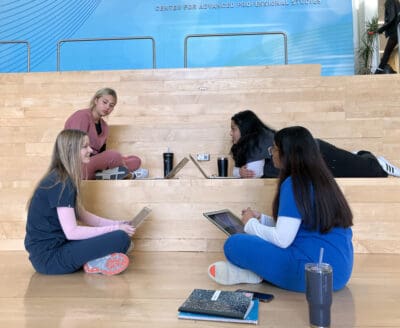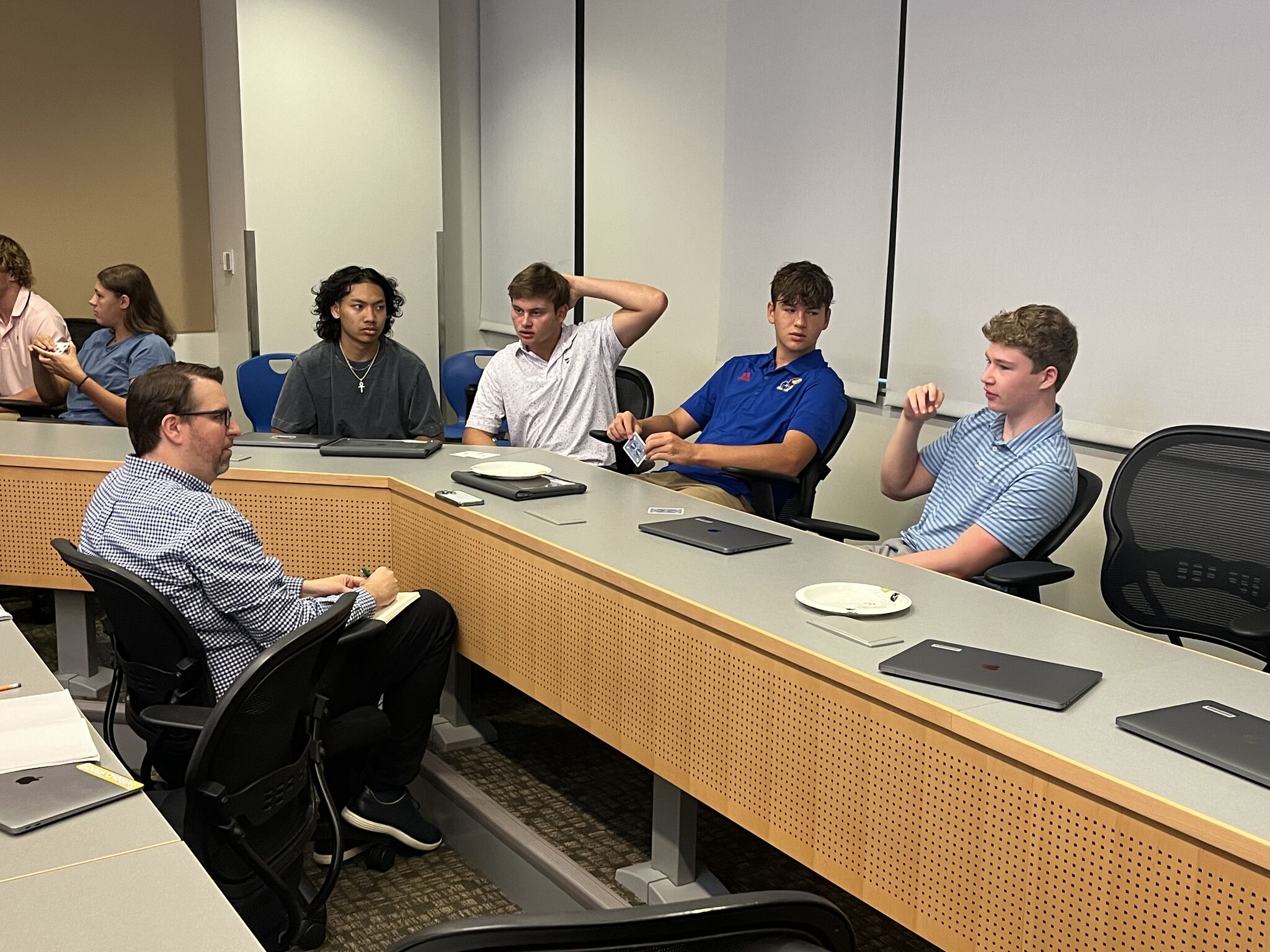
Student Insights Drive Design of Career Navigation Tools
October 16, 2024
At a glance
JFF, ASA, and the CAPS Network offered high school students an opportunity to explore the field of product development and share insights about features for career navigation tools.
The newly formed ASA Center for Career Navigation at JFF is on a mission to design and develop tools that future generations of workers and learners can use to navigate their career and education journeys. And one of the center’s first initiatives illustrates that the best way to do that is hand in hand with the young people who will use those tools
In September, Jobs for the Future (JFF) and American Student Assistance (ASA) partnered with the Center for Advanced Professional Studies (CAPS) Network, which runs experiential career education programs across the country, to offer a hands-on learning experience in which high school students could explore the field of product management while directly contributing to the conceptualization of a product the ASA Center for Career Navigation at JFF is building.
The event, which took place at the Blue Valley CAPS facility in Overland Park, Kansas, featured a two-hour activity structured to mimic real-world product development processes. More than 50 students participated, mostly juniors and seniors ages 16-18 from high schools throughout Blue Valley School District, which serves three Kansas communities.
The CAPS Network: Where Education Meets Industry
The CAPS Blue Valley facility provided a great setting for the ASA Center for Career Navigation at JFF’s September event. Known for what it calls a profession-based learning approach, the CAPS Network focuses on offering students real-world experiences and makes an intentional effort to engage with industry partners, exemplifying the kind of innovative educational model that’s required to prepare students for careers in an ever-evolving job market. CAPS programs are built on a scalable framework that can be adapted to the needs of local industries, and the nonprofit organization has expanded this model to 117 programs across 25 states and four countries since its launch in 2009.
In CAPS programs, students split their time between traditional classes and immersive, profession-based learning experiences that are often offered in facilities designed to mirror professional workspaces—sometimes even co-located in industry partners’ facilities.
The CAPS profession-based learning model bridges classroom knowledge and real-world applications of that knowledge. CAPS experiences go beyond internships or job shadowing activities, immersing students in authentic professional environments to work on real projects and business problems.
CAPS Network President and Executive Director Corey Mohn says the approach gives young people a unique opportunity to explore career pathways. “Profession-based learning empowers students to take ownership of their learning journey and discover their passions through hands-on experiences in high-demand fields,” he says.
Reimagining Career Navigation
Jeff Bulanda, vice president of the ASA Center for Career Navigation at JFF, opened the activities with a short presentation introducing the students to the field of product management. The students were then divided into teams and asked to brainstorm and develop concepts for a digital career navigation platform and present their ideas to the room. They focused on customer journey mapping and created basic wireframes that they shared in their presentations.
Jointly developed by CAPS, JFF, and ASA, the learning experience was based on a design that incorporated the CAPS Network’s expertise in career-oriented learning and JFF and ASA’s knowledge of career navigation challenges. The outcome benefited everyone involved. The students learned about the product management field, and the team from the ASA Center for Career Navigation at JFF gained valuable insights from the target users of the career navigation tools they’re developing.
Jeff Bulanda, Vice President, ASA Center for Career Navigation at JFF
We often talk about building for the future, but rarely do we invite the future to build with us.
Insights From the Event
By engaging high school students in a challenge focused on creating a career navigation platform, JFF and ASA tapped into a wellspring of fresh ideas that only people navigating the complexities of early career decisions could provide. Among other things, the challenge revealed that young people want career navigation tools with features like these:
- Professional networking with a “modern” twist: Students told us they want a platform that combines elements of professional networking with engaging user-friendly interfaces they’re accustomed to in their daily digital interactions. They envision a space that feels as professional as LinkedIn but as intuitive and engaging as the other social media apps they use daily.
- Authenticated information: Participants expressed a strong desire for verified content from industry professionals, coupled with honest reviews from peers about educational programs and career paths.
- Comprehensive career insights: Students want a holistic view of career paths, including detailed job descriptions along with information about likely day-to-day responsibilities, starting salaries and the potential for financial growth, educational requirements and other opportunities to develop required skills, career progression and advancement, the social and cultural impacts of working in certain professions, and emerging industries and non-traditional career options.
- Interactive and personalized features: They said it would be great if a platform also included interactive elements such as personality quizzes that link directly to potential career paths, visual representations of career trajectories, and interfaces that enable side-by-side comparisons of the costs and benefits of products, programs, and resources like scholarships and internships
Students also emphasized the importance of accessibility, suggesting that the ideal platform should be both web-based and mobile-friendly for easy access across devices.
The ideas generated during this challenge will inform the development of future career navigation products and services by the ASA Center for Career Navigation at JFF, ensuring that the next generation of tools will be more intuitive, relevant, and impactful for young users. JFF, ASA, and CAPS are committed to continuing this collaborative approach, with plans for follow-up surveys and potential iterations of the event at other CAPS locations.
It’s empowering to know that our ideas could help other students find their path.”
17-year-old participant in the Blue Valley CAPS event
The Power of Youth Perspective
The students expressed enthusiasm and shared innovative thinking throughout the event. Their participation not only provided valuable input but also demonstrated the potential for young people to actively shape the tools that will guide their futures. “We’re not just users of career tools; we can be creators too,” said one 17-year-old participant. “It’s empowering to know that our ideas could help other students find their path.”
Bulanda emphasized the importance of listening to young people during the design and development process. “Ensuring that people ages 16-24 are actively involved in shaping our initiatives is crucial to our mission of providing all of them with the tools they need to navigate their careers and secure quality jobs,” he said. “We often talk about building for the future, but rarely do we invite the future to build with us.”

“At ASA, we believe that co-creating learner-centered, digital career readiness solutions with Gen Z at the table will result in more engaging experiences that enable all young people to explore and experiment with career possibilities that match their strengths and interests and navigate a path to economic success,” said Judy Goldstein, senior vice president of public relations and strategic communications at ASA. “This product development challenge is one example of how we apply this proven strategy in creating best-in-class digital experiences for young people.”
It’s clear that the path to effective career navigation tools lies not just in advanced technology or industry expertise but in the voices and experiences of the students and early-career workers who will use them. This event set a precedent for similar activities in the future. It illustrates that, when it comes to preparing for the future of work, young people are the greatest resource and the most important collaborators education and workforce development professionals can have.
This challenge served as a reminder that in a rapidly changing world, the best way to predict the future is to create it—hand in hand with those who will inherit it.
Help Us Shape the Future of Career Navigation
The collaboration between JFF, ASA, and the CAPS Network showcases the power of engaging young people in efforts designed to help shape their future career paths. But this is just the beginning. We invite educators, industry professionals, and community leaders to join us in this important work.
To learn more about how the ASA Center for Career Navigation at JFF is shaping the future of career navigation for young people, visit our web page on JFF.org.
Together, we can ensure that the next generation has the tools and support they need to navigate their careers successfully.